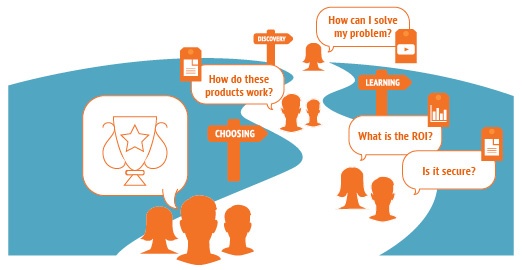 Acquiring leads is only the beginning. To turn those leads into actual sales opportunities, marketers must align their content to buyer needs, processes, and preferences at each stage of their buying journey.
Acquiring leads is only the beginning. To turn those leads into actual sales opportunities, marketers must align their content to buyer needs, processes, and preferences at each stage of their buying journey.
A journey stage is a particular phase in the buyers’ journey that has its own name and definition based on the buyer’s needs, activities, mindset, and desired outcome at that point. In the following, I’ve shared common B2B buyer needs and content preferences at each stage of the buying journey, along with tips to creating content that fulfills those needs. You can use this as a guide for creating your own specific journey maps that inform your strategic content planning and creation.
Stage 1: Discovering
In Discovering, the buyer has reached a tipping point, realizing they have a pain point they need to learn more about. The buyer conducts educational research to better understand the pain point they’re experiencing, which includes defining the problem, understanding potential causes, seeing how others have tackled the problem, and exploring best practices to address the issue. Based on this research, the buyer clearly defines the problem and decides that it’s worth moving forward to address it.
Buyer mindset: I want to learn more about this pain point from analysts, experts, trade magazines, and influencers.
Buyer sought outcome: I understand the issue – what’s causing it, how others like me are addressing it, and various ways to tackle it.
Common buyer needs at this stage include:
- Problem definition
- Business justification that it’s worth evaluating possible solutions to address the issue
- Peer examples of addressing the issue
Typical content preferences to address buyer needs at this stage include:
- Educational blogs from vendors and influencers
- Educational infographics and ebooks
- Educational webinars, especially those that feature customer success stories
- Influencer articles
Content Tip: Establish awareness of your company as the go-to thought-leader by offering content that defines the issue facing your buyers, explains the causes and consequences of it, creates urgency to tackle it, and describes how to successfully take it on. The buyer wants to understand best practices and their associated benefits at this point. Show you understand their business challenge and make the point why they should address it this way.
Stage 2: Learning
In Learning, the buyer researches possible solutions to solving their defined problem and begin to identify specific providers. They take into account the various choices available to their business needs and create a broad list of solution options.
Buyer mindset: I need to learn about the various solutions available that can help me address my issue.
Buyer sought outcome: I know which solutions align to my business needs and therefore which ones I need to explore at an in-depth level.
Common buyer needs at this stage include:
- Business and financial justification that it’s worth employing a solution
- Solution requirements/Solution benefits of various solutions
- Solution unique value proposition/ solution comparisons
- Vendor viability
- Relevant vendor experience
Typical content preferences to address buyer needs at this stage include:
- Customer testimonials
- Use case briefs and examples
- Product webinars
- Executive summaries
- ROI calculators
- Data sheets
- Product whitepapers
- Feature comparisons
- Video demos
Content Tip: Your buyers are still not ready to buy, but they want to dig even deeper into their challenges and how to address them. This stage is tricky because you want to still provide educational content, but at a more in-depth, sophisticated level than before. Think of prospects as this stage as advanced learners, rather than beginner learners as they were in Discovering. And now, they want to learn more about your product. In this stage, you can influence the buyer though content that establishes buying criteria, identifies business and technical needs, and aligns your solution to those needs.
Stage 3: Choosing
In Choosing, the buyer compares and contrasts solutions, cuts their broad list of solution options into a short list, and then makes a final decision.
Buyer mindset: I will drill down into specific proposals to determine which one best fits our needs.
Buyer sought outcome: I’ve chosen which solution to move forward with.
Common buyer needs at this stage include:
- Finance and IT buy-in
- Pricing options and TCO
- Vendor viability
- Solution fit
- Vendor solution proof points (case studies, references, pilots)
- Cross-functional alignment
- Vendor support capabilities
Typical content preferences to address buyer needs at this stage include:
- Feature/function comparisons
- Live video demos or tutorials
- Customer case studies
- Customer reference calls
- Data sheets
- TCO calculation
- ROI calculators
- Presentations by vendor finalists
Content Tip: Here, you must prove you’re the best vendor through content that matches your capabilities to the buyer’s criteria, validates trust and expertise, and proves ROI. Ensure your content addresses buyer concerns and continues to establish trust that you’re a vendor who deeply understands their business challenges and goals, and who will be a reliable partner if they need help at any point.
Developing journey maps is critical to informing your planning and development of high quality content that motivates buyers to continue interacting with you and ultimately choose you. Learn more here about how you can use Akoonu’s Content Planning module to plan content by persona and journey stage, and use it conjuntion with our freemium Audience module for developing insightful personas and journey maps.

